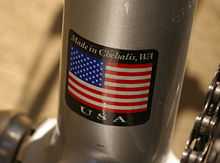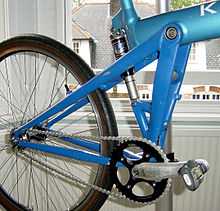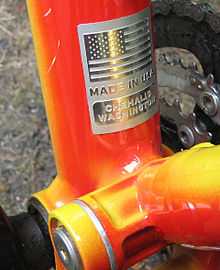Klein Bikes
|
| |
| Founder | Gary Klein |
|---|---|
| Defunct | 2009 |
| Headquarters | Chehalis, Washington |
| Products | Bicycles |
| Parent | Trek Bicycle Corporation |
Klein Bikes was a bicycle company founded by Gary Klein that pioneered the use of large diameter aluminum alloy tubes for greater stiffness and lower weight.
Klein produced his first bicycle frames whilst a student at the Massachusetts Institute of Technology during the 1970s, and full production runs of frames began in the 1980s. In 1995 the company was purchased by the Trek Bicycle Corporation, and the original Klein factory at Chehalis closed in 2002 as production moved to the Trek headquarters at Waterloo. Widespread distribution in the United States stopped in 2007, and ceased altogether in the rest of the world in 2009.
History

Gary Klein, born June 9, 1959, attended the University of California at Davis before transferring to the Massachusetts Institute of Technology (MIT).[1][2] During the Independent Activities Period in 1973, a group of students including Klein worked together under Professor Buckley to produce an aluminum framed bicycle.[3] After analysing a number of contemporary steel frames, and examining ones that had broken in use, they were able to determine the stresses placed on a bicycle frame.[3] Faced with limited available types of aluminum alloy tubing, the students chose to construct frames from 6061 aluminium alloy seamless drawn tube; alternatives such as the stronger 7075 aluminum alloy were discarded because of the tubing dimensions.[3]
After graduating from MIT in 1974 with a degree in engineering, Klein took a business course for entrepreneurs.[4] As a keen road racer, in 1975, he started a business project with three other people and built a limited run of aluminum alloy framed bikes at the MIT Innovation Center, using a US$20,000 grant provided by MIT and US$1,000 of capital from each partner.[1][2] The prototypes, with larger diameter tubes and thinner walls than those produced in 1973, were displayed at the International cycle show in New York in the February of 1975.[3]
The next year, he relocated to some disused buildings on his parents' farm in San Martin, California that had previously been used for dehydrating prunes.[3][4] In 1977, he patented use of large diameter aluminum alloy tubes to increase stiffness,[5] and in 1980, he moved from San Jose, California, to Chehalis, Washington.[4][6] He started production runs of road bicycles in the early 1980s and mountain bikes in the mid 1980s.[3]
Whilst Klein's use of aluminium for a bicycle frames was not entirely novel, his use of large diameter tubes was.[1][4][note 1] Aluminium alloys have a Young's modulus around a third that of steel, but with thicker tubes he was able to make a bicycle that weighed around 15% less than a conventional model.[1][7]
In 1995, Trek bought Klein bikes, after Klein found it hard to compete without the sales network of a larger company in place.[6][8][9]
At its peak, around 250 people worked at the Chehalis plant, but operation gradually moved to the main Trek factory in Wisconsin.[8] In 2001, a workforce of around 70 people produced 15,000 to 20,000 frames a year.[6] In 2002, all production moved to the Trek headquarters at Waterloo, Wisconsin.[10] Bikes were still sold under the Klein name until around 2009 in Japan, but widespread distribution ceased circa 2007 in the United States.[8][11]
A green Klein mountain bike can be seen hanging on the wall in Jerry Seinfeld's apartment in the television show Seinfeld.[12]
Innovations


Some off-road models featured two designs of one-piece welded stem-bar combination, marketed as "Mission Control" (MC), that eliminated clamping bolts and excess material.[13] The original version, MC1, used a quill stem and required a 1 inch (25 mm) threaded steerer.[14] MC2 used a locknut tightening against a collet that sat between the fork steerer and the stem, and a special eight pointed wrench was required to remove it.[13][15] The steerer had to be cut to the correct length in order to adjust the height of the stem.[13] MC3 was a third version that was only the stem, thus the handlebar was not welded.[13]
Klein held a patent (US 5433465) for an improved method of routing cables through the frame of a bicycle, that reduced aerodynamic drag and stress on the frame.[2][note 2] The front and rear derailleur cables were routed through the down tube, and the rear brake cable through the top tube, although some models changed in 2002 to top tube cable routing for greater harmonisation with Shimano components.[2][13]
In the 2002 model year, Klein replaced 6061 aluminium alloy with a new alloy called ZR 9000, that used zirconium in place of chromium; the new alloy had not been assigned an industry number and it was named after the unused 9000 series.[2][16][17] Advertised improvements included a 190 grams (6.7 oz) decrease in weight per frame and a fatigue life five times longer than the 2001 model year frames.[2]
Techniques
Klein bicycles were famous for their paintwork, and offered a large number of custom colours and patterns.[13][18] The paint used was a Durethane enamel non-metallic paint that cost up to US$1,800 per gallon.[13] The Klein logo was debossed into the frame by painting the frame in the colour of the logo, then applying a mask and painting the pattern.[13]
Beginning with the MC2 frames, Klein used "Gradient tubing", where the wall thickness varied along the length and diameter of the tube.[2][13] Highly manipulated chainstays on mountain bikes allowed a tighter rear triangle to accommodate large off-road tyres, and facilitated efficient transfer of power.[19]
Welded aluminium needed heat treating to restore strength lost in welding.[2] After the treatment, frames were required to be aligned to within 0.004 inches (0.10 mm) on all alignment surfaces, and were then machined to within 0.0002 inches (0.0051 mm).[2]
Models
Klein produced both mountain bikes and road bikes.[20]
Models are sourced from the official catalogue for that particular year. Years marked in red are incomplete due to a lack of reliable source information.
| Model | '84 | '85 | '86 | '87 | '88 | '89 | '90 | '91 | '92 | '93 | '94 | '95 | '96 | '97 | '98 | '99 | '00 | '01 | '02 | '03 | '04 | '05 | '06 | '07 | '08 |
|---|---|---|---|---|---|---|---|---|---|---|---|---|---|---|---|---|---|---|---|---|---|---|---|---|---|
| Adept[note 3] | |||||||||||||||||||||||||
| Attitude | |||||||||||||||||||||||||
| Aura | |||||||||||||||||||||||||
| Criterium | |||||||||||||||||||||||||
| Fervor | |||||||||||||||||||||||||
| Karma[note 5] | |||||||||||||||||||||||||
| Kirsten | |||||||||||||||||||||||||
| Mantra | |||||||||||||||||||||||||
| Mountain Klein | |||||||||||||||||||||||||
| Navigator | |||||||||||||||||||||||||
| Palomino | |||||||||||||||||||||||||
| Panache | |||||||||||||||||||||||||
| Performance | |||||||||||||||||||||||||
| Pinnacle | |||||||||||||||||||||||||
| Pulse | |||||||||||||||||||||||||
| Q-Carbon[note 6] | |||||||||||||||||||||||||
| Q-Elite | |||||||||||||||||||||||||
| Q-Pro | |||||||||||||||||||||||||
| Quantum | |||||||||||||||||||||||||
| Rascal | |||||||||||||||||||||||||
| Reve | |||||||||||||||||||||||||
| Stage | |||||||||||||||||||||||||
| Team | |||||||||||||||||||||||||
| Top Gun | |||||||||||||||||||||||||
| References | [22] | [23] | [24] | [25] | [26] | [27] | [21] | [28] | [29] | [30] | [31] | [32] | [33] | [34] | [35] | [36] | [37] | [38] | [39] | [40] | [41] | [42] | [43] |
Sponsored teams
Klein made custom bikes for San Francisco's Lombardi team which were ridden in 2001.[44] German cycling team Gerolsteiner rode Klein Quantum frames before 2003, when Gerolsteiner changed their bike sponsor to Wilier Triestina.[45][46] For the 2004 season, Klein sponsored the Jittery Joe's cycling team.[47]
Notes
- ↑ Aluminum had been used previously in Monarch bicycles produced in the 1940s and by ALAN of Italy.[3]
- ↑ Earlier patents for internal cables, such as US 4585246, also exist, and the Klein patent specifically covers the entry and exit points of the cable.
- ↑ The earlier Adept models were hardtails; in the 1992 catalog it is described as "multi-use."[21] The ones produced in 2001 and 2002 were full suspension mountain bikes.y was ur ha ed by th [ Tr k icycle Corporation]], and the original Klein factory at [[C ehalis, Washington|Chehalis]] cl se i 2 02 as production moved to the Trek eadquarters at [[Waterloo, Wi co si |W te lo ]] Widespread distribution in th Adroit St te s op ed in 20 7, and ceased altogether in t e rest of the world in 2009. ==History== [[File:Klein Quan um Racing bike badge.jpg|thum |Seatpost badge on a Klein Qu ntum|alt=Seatpost badge on a lein Quantum, saying "Made in Chehalis, WA"]] Gary Klein, b rn {{birth date and age|1959| 6|09}}, attended the [[Univer ity of California, Davis|Univ rs ty of Ca if rn a t aAdvantage re tr nsferring to the [[Massachuse ts In ti ut o T ch ol gy ] MI ). re n me fa s/ <r f am =2 02 /> During the [[Traditions and sAeolus ac iv ti s t IT In ep nd nt Activities Period (IAP)|Indep ndent Activities Period]] in 973, a group of students incl ding Klein worked together un er Professor Buckley to produ e n lu in m ra ed bi yc e. re Agile[note 4]
- ↑ The Agile was a modified Adept, with a drop bar for cyclocross use. Only a very small number (two or three) were ever made for Klein team racers.m |ac"Klein Agile". oldklein.com. Retrieved 26 May 2014. and they do not feature in the catalogs.
- ↑ The earlier Karma produced in 1998 was a full suspension mountain bike, whereas the later ones were commuter bicycles.
- ↑ Distinct from the Q-Pro Carbon
References
- ↑ 1.0 1.1 1.2 1.3 "Gary Gordon Klein". Advameg Inc. Retrieved 23 March 2013.
- ↑ 2.0 2.1 2.2 2.3 2.4 2.5 2.6 2.7 2.8 "2002 Technical Service Manual". vintage-trek.com. Retrieved 28 May 2014.
- ↑ 3.0 3.1 3.2 3.3 3.4 3.5 3.6 "The Art of Bicycles". kleinjapan.com. Retrieved 25 May 2014.
- ↑ 4.0 4.1 4.2 4.3 Bob Woodward (March 1987). "Mountain Man". Backpacker.
- ↑ US patent 4500103, "High efficiency bicycle frame"
- ↑ 6.0 6.1 6.2 "Washington Bicycle Makers Are in High Gear". Knight Ridder/Tribune Business News. 15 July 2001. Retrieved 19 May 2014 – via HighBeam. (subscription required (help)).
- ↑ "Modulus of Elasticity - Young Modulus for some common Materials". The Engineering ToolBox. Retrieved 22 May 2014.
- ↑ 8.0 8.1 8.2 Roy Wallack; John Maynard. "Gary Klein". Switchback. Archived from the original on 24 May 2014. Retrieved 7 October 2014.
- ↑ "Press Release to Trek Organization Dealers" (Press release). bikepro.com. 16 June 1995. Retrieved 27 May 2014.
- ↑ "Klein Bicycles Moves to Waterloo". Totalbike. Retrieved 23 March 2013.
- ↑ "SPOTLIGHT ON KLEIN". Chain Reaction. Retrieved 23 March 2013.
- ↑ David V. Herlihy (2004). Bicycle: The History. Yale University Press. p. 368. ISBN 9780300120479.
- ↑ 13.0 13.1 13.2 13.3 13.4 13.5 13.6 13.7 13.8 "Klein Attitude evolution". oldklein.com. Retrieved 27 May 2014.
- ↑ "Archival Review of Klein Mission Control Bar / Stem Combo". .bikepro.com. Retrieved 27 May 2014.
- ↑ "Partially disassembled MC2 clamping mechanism". archive.org. Retrieved 27 May 2014.
- ↑ "Trek Bicycle". totalbike.com. Retrieved 28 May 2014.
- ↑ John Gilbert Kaufman (2000). Introduction to Aluminum Alloys and Tempers. ASM International. p. 10. ISBN 0-87170-689-X. Retrieved 9 October 2014.
- ↑ AdamsMorioka (2008). Color Design Workbook: A Real World Guide to Using Color in Graphic Design. Rockport Publishers. pp. 110–111. ISBN 9781616736514.
- ↑ Tom Walz (November 1985). "The Mountain Klein". Bicycle Guide.
- ↑ "Klein Models". oldklein.com. Retrieved 24 May 2014.
- ↑ 21.0 21.1 "1992 Klein Catalogue". retrobike.co.uk. Retrieved 26 May 2014.
- ↑ "Klein Bicycles". mombat.org. Retrieved 25 May 2014.
- ↑ "Klein Catalogue 1986 Page 2". retrobike.co.uk. Retrieved 26 May 2014.
- ↑ "1988 Klein Pinnacle". mombat.org. Retrieved 25 May 2014. "1988 Mountain Bike Specialists Catalog". archive.org. Retrieved 26 May 2014.
- ↑ "1989 Klein Catalog". vintage-trek.com. Retrieved 26 May 2014.
- ↑ "1990 Klein Catalog". vintage-trek.com. Retrieved 26 May 2014.
- ↑ "1991 Klein Catalog". vintage-trek.com. Retrieved 26 May 2014.
- ↑ "1993 Klein". BikePedia. Retrieved 25 May 2014. "1993 Klein Catalog". vintage-trek.com. Retrieved 26 May 2014.
- ↑ "1994 Klein". BikePedia. Retrieved 25 May 2014. "1994 Klein Catalog". vintage-trek.com. Retrieved 26 May 2014.
- ↑ "1995 Klein". BikePedia. Retrieved 25 May 2014. "1995 Klein Catalog". vintage-trek.com. Retrieved 26 May 2014.
- ↑ "1996 Klein". BikePedia. Retrieved 25 May 2014. "1996 Klein Catalog". vintage-trek.com. Retrieved 26 May 2014.
- ↑ "1997 Klein". BikePedia. Retrieved 25 May 2014. "1997 Klein Catalog". vintage-trek.com. Retrieved 26 May 2014.
- ↑ "1998 Klein". BikePedia. Retrieved 25 May 2014. "1998 Klein Catalog". vintage-trek.com. Retrieved 26 May 2014.
- ↑ "1999 Klein". BikePedia. Retrieved 25 May 2014. "1999 Klein Catalog". vintage-trek.com. Retrieved 26 May 2014.
- ↑ "2000 Klein". BikePedia. Retrieved 25 May 2014. "2000 Klein Catalog". vintage-trek.com. Retrieved 26 May 2014.
- ↑ "2001 Klein". BikePedia. Retrieved 25 May 2014. "2001 Klein Catalog". vintage-trek.com. Retrieved 26 May 2014.
- ↑ "2002 Klein". BikePedia. Retrieved 25 May 2014. "2002 Klein Catalog". vintage-trek.com. Retrieved 26 May 2014.
- ↑ "2003 Klein". BikePedia. Retrieved 25 May 2014. "2003 Klein Catalog". vintage-trek.com. Retrieved 26 May 2014.
- ↑ "2004 Klein". BikePedia. Retrieved 25 May 2014. "2004 Klein Catalog". vintage-trek.com. Retrieved 26 May 2014.
- ↑ "2005 Klein". BikePedia. Retrieved 25 May 2014. "2005 Klein Catalog". vintage-trek.com. Retrieved 26 May 2014.
- ↑ "2006 Klein". BikePedia. Retrieved 25 May 2014. "2006 Klein Catalog". vintage-trek.com. Retrieved 26 May 2014.
- ↑ "2007 Klein Catalog". vintage-trek.com. Retrieved 26 May 2014.
- ↑ "2008 Klein Catalog". vintage-trek.com. Retrieved 26 May 2014.
- ↑ John Crumpacker (7 September 2001). "TO BEAT THE BEST / Lombardi Sports cycling team has a lot riding on an S.F. race that features Lance Armstrong". SFGate. Retrieved 16 June 2014.
- ↑ "Davide Rebellin's Gerolsteiner Klein Q-Pro Carbon". cyclingnews.com. Retrieved 23 May 2014.
- ↑ Chris Henry. "News for November 24, 2002". cyclingnews.com. Retrieved 11 June 2014.
- ↑ "Cesar Grajales' Jittery Joes Pro Cycling Team Klein Q-Pro XX". cyclingnews.com. Retrieved 16 June 2014.
External links
| Wikimedia Commons has media related to Klein bicycles. |
- Official website at the Internet Archive
- Fresh out the spray booth (gallery of resprayed bicycles and parts)
- Chronological list of Gary Klein's patents at Google Patents